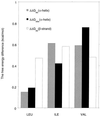Energetics of the interaction between water and the helical peptide group and its role in determining helix propensities
- PMID: 10984522
- PMCID: PMC27101
- DOI: 10.1073/pnas.200343197
Energetics of the interaction between water and the helical peptide group and its role in determining helix propensities
Abstract
The alanine helix provides a model system for studying the energetics of interaction between water and the helical peptide group, a possible major factor in the energetics of protein folding. Helix formation is enthalpy-driven (-1.0 kcal/mol per residue). Experimental transfer data (vapor phase to aqueous) for amides give the enthalpy of interaction with water of the amide group as approximately -11.5 kcal/mol. The enthalpy of the helical peptide hydrogen bond, computed for the gas phase by quantum mechanics, is -4.9 kcal/mol. These numbers give an enthalpy deficit for helix formation of -7.6 kcal/mol. To study this problem, we calculate the electrostatic solvation free energy (ESF) of the peptide groups in the helical and beta-strand conformations, by using the delphi program and parse parameter set. Experimental data show that the ESF values of amides are almost entirely enthalpic. Two key results are: in the beta-strand conformation, the ESF value of an interior alanine peptide group is -7.9 kcal/mol, substantially less than that of N-methylacetamide (-12.2 kcal/mol), and the helical peptide group is solvated with an ESF of -2.5 kcal/mol. These results reduce the enthalpy deficit to -1.5 kcal/mol, and desolvation of peptide groups through partial burial in the random coil may account for the remainder. Mutant peptides in the helical conformation show ESF differences among nonpolar amino acids that are comparable to observed helix propensity differences, but the ESF differences in the random coil conformation still must be subtracted.
Figures




References
-
- Baker E N, Hubbard R E. Prog Biophys Mol Biol. 1984;44:97–179. - PubMed
-
- Ben-Naim A. J Phys Chem. 1991;95:1437–1444.
-
- Yang A S, Sharp K A, Honig B. J Mol Biol. 1992;227:889–900. - PubMed
-
- Honig B, Yang A S. Adv Protein Chem. 1995;46:27–58. - PubMed
-
- Avbelj F, Moult J. Biochemistry. 1995;34:755–764. - PubMed
Publication types
MeSH terms
Substances
LinkOut - more resources
Full Text Sources

